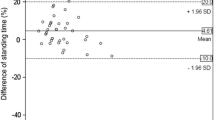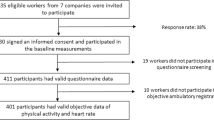Abstract
Purpose
High intensity occupational physical activity (OPA) seem to aggravate health and increase risk of sick leave and early retirement. Most intensity of OPA monitoring has been self-reported, e.g. by rating of perceived exertion (RPE). However, no studies have investigated the precision and risk of bias in RPE reporting during free-living OPA. This study investigated the agreement between OPA intensity in percentage of the heart rate reserve (%HRR) estimated from RPE and device-measured heart rate (HR), and potential bias factors on this agreement.
Methods
The CR10 scale measured RPE at work. The Actiheart monitor measured HR during 24-h a day for 2–4 days. Both RPE and device-worn HR were converted to %HRR. The difference between both %HRR and their limits of agreement was determined in a Bland Altman plot. To detect bias factors, the difference between both %HRR was regressed on age, sex, cardiorespiratory fitness, occupational lifting, medication, consequences of musculoskeletal disorders and the interactions between these factors with device-work %HRR.
Results
Six hundred and twenty-three participants were included in the analysis. Mean difference between RPE-based and device-worn %HRR was 54.6% (SD 19.5). The limits of agreement were wide (11.6–90.1%HRR). Age (0.48%HRR, 95% CI 0.18–0.79) occupational lifting (9.84%HRR, 95% CI 3.85–15.83) and cardiorespiratory fitness (0.41%HRR, 95% CI 0.03–0.79) significantly biased the agreement between the estimations of OPA intensity.
Conclusion
RPE overestimated OPA intensity, and was biased by several factors. Device-worn %HRR should be preferred when evaluating OPA intensity among workers with physically demanding jobs.



Similar content being viewed by others
Availability of data and material
Data are available upon request to and approval by the steering committee of the DPhacto cohort. Information regarding data request can be sent to Andreas Holtermann (aho@nfa.dk).
Abbreviations
- BMI:
-
Body mass index
- bpm:
-
Beats per minute
- CI:
-
Confidence interval
- CRF:
-
Cardiorespiratory fitness
- DPhacto:
-
Danish PHysical ACTivity cohort with Objective measurements
- h:
-
Hours
- HR:
-
Heart rate
- HRR:
-
Heart rate reserve
- %HRR:
-
Percentage of heart rate reserve
- MSD:
-
Musculoskeletal disorders
- OPA:
-
Occupational physical activity
- RPE:
-
Rate of perceived exertion
- SD:
-
Standard deviation
- SHR:
-
Sleeping heart rate
References
Andersen LL, Clausen T, Mortensen OS, Burr H, Holtermann A (2012a) A prospective cohort study on musculoskeletal risk factors for long-term sickness absence among healthcare workers in eldercare. Int Arch Occup Environ Health 85(6):615–622. https://doi.org/10.1007/s00420-011-0709-5
Andersen LL, Clausen T, Persson R, Holtermann A (2012b) Dose-response relation between perceived physical exertion during healthcare work and risk of long-term sickness absence. Scand J Work Environ Health 38(6):582–589. https://doi.org/10.5271/sjweh.3310
Armstrong BG (1996) Optimizing power in allocating resources to exposure assessment in an epidemiologic study. AmJ Epidemiol 144(2):192–197
Assah FK, Ekelund U, Brage S, Wright A, Mbanya JC, Wareham NJ (2011) Accuracy and validity of a combined heart rate and motion sensor for the measurement of free-living physical activity energy expenditure in adults in Cameroon. Int J Epidemiol 40(1):112–122
Åstrand PO, Ryhming I (1954) A nomogram for calculation of aerobic capacity (physical fitness) from pulse rate during submaximal work. J Appl Physiol 7(2):218–221
Barreira TV, Kang M, Caputo JL, Farley RS, Renfrow MS (2009) Validation of the actiheart monitor for the measurement of physical activity. Int J Exerc Sci 2(1):60–71
Bland JM, Altman D (1986) Statistical methods for assessing agreement between two methods of clinical measurement. The Lancet 327(8476):307–310
Bonjer FH (1971) Energy Expenditure. In: Parmeggiana L (ed) Encyclopedia of occupational health and safety, 2nd edn. International Labour Organisation, Geneva, pp 458–460
Borg GAV (1962) Physical performance and perceived exertion. Studia psychologica et paedagogica series altera. Investigations XI CWK Glerup, Lund
Brage S, Brage N, Franks PW, Ekelund U, Wareham NJ (2005) Reliability and validity of the combined heart rate and movement sensor actiheart. Eur J Clin Nutr 59(4):561–570
Brage S, Brage N, Franks PW, Ekelund U, Wong MY, Andersen LB, Froberg K, Wareham NJ (2004) Branched equation modeling of simultaneous accelerometry and heart rate monitoring improves estimate of directly measured physical activity energy expenditure. J Appl Physiol 96(1):343–351
Clays E, De BD, Van HK, De BG, Kittel F, Holtermann A (2012) Occupational and leisure time physical activity in contrasting relation to ambulatory blood pressure. BMC Public Health 12:1002
DiDomenico A, Nussbaum MA (2011) Effects of different physical workload parameters on mental workload and performance. Int J Ind Ergon 41(3):255–260
Foster C, Florhaug JA, Franklin J, Gottschall L, Hrovatin LA, Parker S, Doleshal P, Dodge C (2001) A new approach to monitoring exercise training. J Strength Cond Res 15(1):109–115
Groslambert A, Mahon AD (2006) Perceived exertion : influence of age and cognitive development. Sports Med 36(11):911–928. https://doi.org/10.2165/00007256-200636110-00001
Gupta N, Christiansen CS, Hallman DM, Korshøj M, Carneiro IG, Holtermann A (2015) Is objectively measured sitting time associated with low back pain? A cross-sectional investigation in the NOMAD study. PLoSOne 10(3):e0121159
Holtermann A, Burr H, Hansen JV, Krause N, Søgaard K, Mortensen OS (2011) Occupational physical activity and mortality among Danish workers. Int Arch Occup Environ Health 85(3):305–310
Holtermann A, Mortensen OS, Burr H, S›gaard K, Gyntelberg F, Suadicani P (2010) Physical demands at work, physical fitness, and 30-year ischaemic heart disease and all-cause mortality in the Copenhagen male Study. Scand J Work Environ Health 36(5):357–365
Hull EM, Young SH, Ziegler MG (1984) Aerobic fitness affects cardiovascular and catecholamine responses to stressors. Psychophysiology 21(3):353–360
Jørgensen MB, Korshøj M, Lagersted-Olsen J, Villumsen M, Mortensen OS, Skotte J, Søgaard K, Madeleine P, Thomsen BL, Holtermann A (2013) Physical activities at work and risk of musculoskeletal pain and its consequences: protocol for a study with objective field measures among blue-collar workers. BMC Musculoskelet Disord 14:213
Karvonen MJ, Kentala E, Mustala O (1957) The effects of training on heart rate; a longitudinal study. Ann Med Exp Biol Fenn 35(3):307–315
Korshøj M, Krustrup P, Jespersen T, Søgaard K, Skotte JH, Holtermann A (2013) A 24-h assessment of physical activity and cardio-respiratory fitness among female hospital cleaners: a pilot study. Ergonomics 56(6):935–943
Krause N, Brand RJ, Kauhanen J, Kaplan GA, Syme SL, Wong CC, Salonen JT (2009) Work time and 11-year progression of carotid atherosclerosis in middle-aged Finnish men. Prev Chronic Dis 6(1):A13
Kristiansen J, Korshoj M, Skotte JH, Jespersen T, Sogaard K, Mortensen OS, Holtermann A (2011) Comparison of two systems for long-term heart rate variability monitoring in free-living conditions–a pilot study. Biomed Eng Online 10:27
Kwak L, Proper KI, Hagstromer M, Sjostrom M (2011) The repeatability and validity of questionnaires assessing occupational physical activity–a systematic review. Scand J Work Environ Health 37(1):6–29
Light KC, Obrist PA, James SA, Strogatz DS (1987) Cardiovascular responses to stress: II. Relationsh Aerobic Exerc Patterns Psychophysiol 24(1):79–86
Li CY, Sung FC (1999) A review of the healthy worker effect in occupational epidemiology. Occup Med 49(4):225–229
Louhevaara V (1999) Job demands and physical fitness. In: The occupational ergonomics handbook, pp 261–273
Rechel B, Grundy E, Robine J-M, Cylus J, Mackenbach JP, Knai C, McKee M (2013) Ageing in the European union. The Lancet 381(9874):1312–1322
Sallis JF, Saelens BE (2000) Assessment of physical activity by self-report: status, limitations, and future directions. Res Quat Exerc Sport 71(2 Suppl):S1-14
Scherr J, Wolfarth B, Christle JW, Pressler A, Wagenpfeil S, Halle M (2013) Associations between Borg’s rating of perceived exertion and physiological measures of exercise intensity. Eur J Appl Physiol 113(1):147–155. https://doi.org/10.1007/s00421-012-2421-x
Skotte J, Korshøj M, Kristiansen J, Hanisch C, Holtermann A (2014) Detection of physical activity types using triaxial accelerometers. J Phys Act Health 11(1):76–84
Sukhova GK, Schonbeck U, Rabkin E, Schoen FJ, Poole AR, Billinghurst RC, Libby P (1999) Evidence for increased collagenolysis by interstitial collagenases-1 and -3 in vulnerable human atheromatous plaques. Circulation 99(19):2503–2509
Tanaka H, Monahan KD, Seals DR (2001) Age-predicted maximal heart rate revisited. J Am Coll Cardiol 37(1):153–156
Acknowledgements
The authors would like to acknowledge the DPhacto research group for their massive contributions in the collections and preparation of data. The data collection enabling these analyses was partly supported by a grant from the Danish government (Satspulje). Theses reported analyses was partly funded by public funds, via the Danish Work Environment Research Foundation, grant number 20150067515.
Funding
The study was funded by the project Work-ability, -load and -capacity in collaboration between Department of Occupational and Social Medicine, Holbæk Hospital and The National Research Centre for the Working Environment.
Author information
Authors and Affiliations
Contributions
MK: conceived the idea, analyzed the data and drafted the manuscript. MK and NG: designed the protocol for analysis and MK, NG, AH and OM: discussed the interpretation of the results. MK, AH and MJ: collaborated in the design and protocol for the DPhacto cohort. All authors read, commented and approved the manuscript for submission.
Corresponding author
Ethics declarations
Conflict of interest
The authors declare that they have no conflict of interest.
Ethics approval
Data are collected in accordance to the Declaration of Helsinki, and the local ethical committee approved the design and protocol initial to data collection (H-2-2012-011).
Consent to participate
All participants signed an informed consent to participate initial to data collection.
Consent to publication
All authors gave consent to submit the manuscript.
Additional information
Communicated by Lori Ann Vallis.
Publisher's Note
Springer Nature remains neutral with regard to jurisdictional claims in published maps and institutional affiliations.
Rights and permissions
About this article
Cite this article
Korshøj, M., Gupta, N., Mortensen, O.S. et al. Intensity of occupational physical activity in blue-collar workers: do self-reported rating and device-worn measurements agree?. Eur J Appl Physiol 122, 1293–1301 (2022). https://doi.org/10.1007/s00421-022-04920-8
Received:
Accepted:
Published:
Issue Date:
DOI: https://doi.org/10.1007/s00421-022-04920-8




